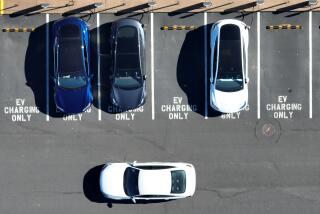Wake Up, Delegation: Transit Funds A-Going : California could lose in congressional end run
- Share via
Amid a deluge of dueling rules, amendments and the usual legislative bombast, the House will soon vote on next year’s transportation appropriation bill. And if it doesn’t act responsibly, California, along with 40 other states, could be robbed of its fair share of badly needed highway improvement funds so that nine states can disproportionately benefit.
Two years ago, Congress approved the Intermodal Surface Transportation Efficiency Act (ISTEA), setting new federal transportation policy for the next six years. Interstate highways dominated the federal transportation agenda for a generation, but ISTEA charts a new course. Congress continues to spend generously on highway construction and improvement, but it also voted to give states much more discretion over the use of federal funds, allowing them to allocate the money to other forms of mass transit, according to their needs, as well as highway construction. To divide federal funds among the states, ISTEA also set forth a formula that took into account a state’s population, highway traffic and existing miles of road, among other criteria. The House approved ISTEA--including this allocation formula--in November, 1991, by an overwhelming margin of 372 to 47.
Rep. Bob Carr (D-Mich.), who voted with that majority, now wants to do an end run around established federal transit policy. As chairman of the House transportation appropriations subcommittee, Carr has rejiggered the $305 million in the pending transportation spending bill to heavily favor demonstration projects in a handful of states. His bill overrides the House Public Works Committee’s allocation of this $305 million through the ISTEA formula. Instead, it takes $13 million of the $27 million earmarked for California, along with chunks of funds from other states, and dispenses it most generously among lucky states. Although California receives transportation funding from several sources, these funds represent a portion of its total federal transportation allocation that the state could ill do without.
Carr’s home state of Michigan could receive $109 million, or one-third of the funding for the next fiscal year. The other winners are Indiana, Kentucky, Minnesota, North Carolina, Ohio, Texas, Utah and Virginia.
And rather than give those states the flexibility to decide where best to spend those funds, the money is now targeted to specific projects, many of them demonstration projects, in specific districts. Some of those districts just happen to be those which members of the Appropriations Committee represent. The polite term for this sort of legislative sleight of hand is micro-management. But we’d prefer to call it old-fashioned pork-barrel spending.
Carr believes that Congress has not paid enough attention to demonstration projects. He is also concerned that the ISTEA formula shortchanges some states that have pressing transportation needs. He wants to move toward an appropriations strategy that weighs the cost of a proposed project against its value in improved safety, air quality, congestion, travel time and other economic benefits. A reasonable principle, but why then does Michigan stand to receive so much money under this scheme?
California, along with most other states, will be a big loser if this bill passes. Thursday the Appropriations Committee decided to take a new look at Carr’s package before sending it on to the full House. California’s representatives need to keep their eyes and ears wide open on this one.
More to Read
Sign up for Essential California
The most important California stories and recommendations in your inbox every morning.
You may occasionally receive promotional content from the Los Angeles Times.










